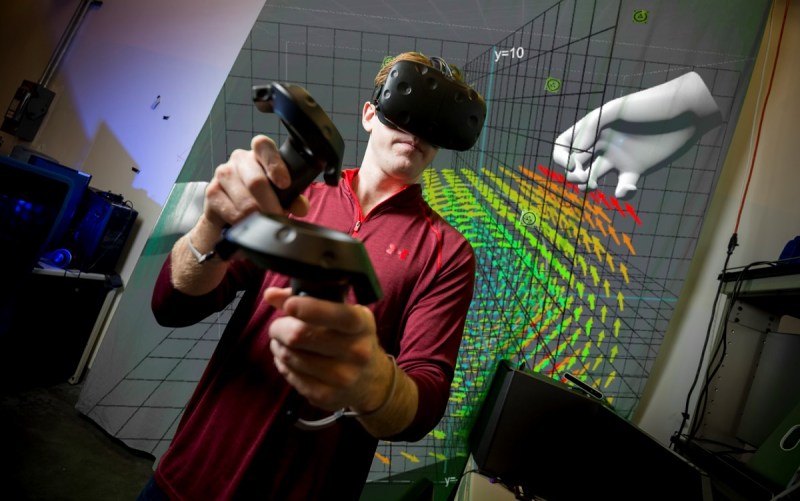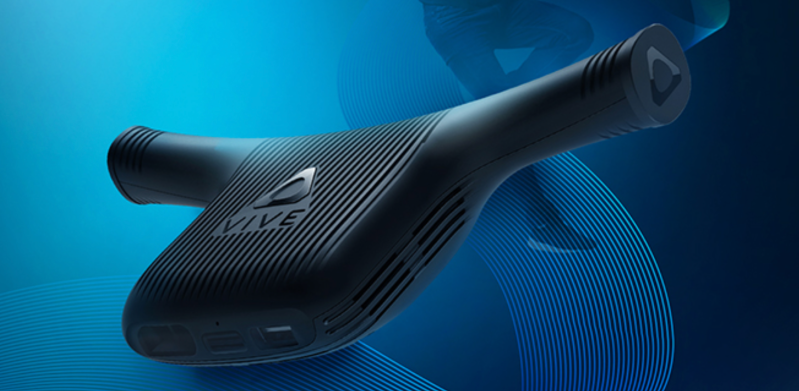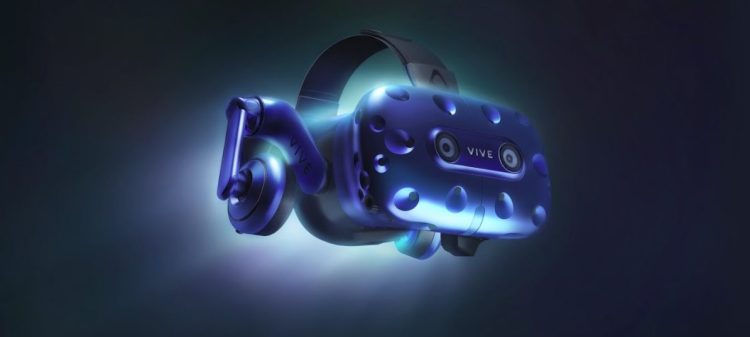GamesBeat: I caught your comment that you’re embracing this whole space. You’re not necessarily only about VR.
Steiber: Yeah, exactly. The view – what we call Vive Reality – is this kind of continuum. We start here with you and me in the real world, and then together we have an augmented reality to discuss something around a product, or maybe we’re just playing chess. Then we can move in to something fully immersive. We’re experimenting at this stage. We’ve started to see applications where you move seamlessly from something augmented to something fully immersive. There are lots of B-to-B and consumer applications there.
I do think that, as I also mentioned—when you see things like VR chat, it’s becoming a media platform. People are tuning in from outside VR. It’s almost like the esports phenomenon. I’ve run esports businesses in the past, and I can see the heroes in VR broadcasting to the people outside. Hopefully that will also make it more exciting for people to try it out and become that sort of power user.
GamesBeat: With the size of the market, how do you set expectations about where it’s settling or where it’s going?
Steiber: I think what’s happening—on the one hand there’s much more content, many more great experiences. The awareness is slowly growing. You have to experience it to understand it, so it takes longer than some other technologies. The total cost of ownership, the price, compared to the value you get, is falling much more into place. This quarter is going to be an important quarter.
I do think that next year, as we move to all-in-one devices where you don’t need a PC or a phone, the cost of ownership will be much more affordable. You’ll be able to move into the living room and have social experiences, maybe have your friends participate on their phones or the TV. It’s an exciting time. For us, as we look at how to expand from the core gaming audience, I think that lifestyle—if you look at sports, for example, many people feel very passionate about sports. They’d pay anything to follow their favorite teams. Both interactive experiences and live event-based or cinematic experiences are going to be more important as we move into next year.
There’s something around the power of music, how that transmits emotion. I don’t think we’ve figured out what that is in VR yet. But I think we see that in everything from games like Beat Saber or Audioshield, to the way people go in and have musical experiences, to these music creation apps as well. And of course you can go to events and watch your favorite artists. Music and sports are two things where we can increase the pool a bit, and then go beyond the hardcore gamer audience to have more social and lifestyle-oriented content. That’s something we’ll see this holiday and in the beginning of next year.

Above: HTC Vive X
GamesBeat: The VR arcade experiences, are they still a good way to get people more engaged?
Steiber: What’s fabulous with that is, most people probably have their first VR experience in one of those establishments. That’s why I want to make sure we’re there with the best content, so you have a great experience. If you look at Arizona Sunshine, for example, for them to take the core of the game and make it into something social, something that uses a gun or a haptic suit, something unique—that’s going to be much easier than building something from scratch.
That’s what I want to do. I want to work with some of these key developers to make sure we have unique experiences that are truly mind-blowing, and then help out the arcade operators. This is a tough business, unless you have a lot of free foot traffic. You need something that stands out. These are the people who will evangelize VR and help developers monetize and build their brands. They’ll bring in the next generation of customers. It’s an important strategic part of the ecosystem.
GamesBeat: Do you think people are still longing for that Ready Player One world, where you live in VR? Has that wave of hype helped crystallize where everyone wants to go?
Steiber: The movie is kind of a dark future. At the end, not to spoil too much, they decide that the Oasis won’t be open on certain days, so have to spend some time hanging out in the real world. I do think that in society today, if you look at the amount of time we spend on social media, for example, or looking at a new notification on our phone from Twitter or Facebook or our email—it’s a drug. You become addicted to it. And that’s a very poor experience. It’s not particularly immersive.
One could imagine that if you have a really great experience, an immersive experience, you’d want to spend a lot of time there. I don’t think that we’re there yet. The experiences aren’t there. We’re working on the technology. Clearly we’re on the way, though. It’s not supposed to be until the 2040s, so we have some time to get there.
GamesBeat: I saw that Otoy and Lightfield Labs want to work together to create a real holodeck.
Above: HTC Vive Tracker
Steiber: Our company is working on this Vive reality. The idea is essentially that AR and VR are an interface with the computer, or with AI. We believe that in order to get there, you need to be connected to the cloud. You need to have these fifth-generation networks, which not only have bandwidth, but also very low latency, so you can move the computing out to the cloud, and thereby make sure that you don’t have all the processing in the device. It can be much lighter. We’re getting to that kind of future. We’re thinking about what are the right kind of experiences and what might be the right timing for the AI and the network and the VR/AR hardware to come together.
GamesBeat: I’ve heard that 5G will help, but it doesn’t necessarily guarantee the latency everyone will want.
Steiber: I’m not an expert there. But you can’t be entirely in the cloud, clearly. There are these solutions where the operator can put some of the computing capabilities on the edge, or you have a cable and a very good network. You’re only as good as your weakest link in those kinds of networks. But I do think that there seems to be some evidence that it’s going to work. As we move toward Mobile World Congress we may see some announcements coming up.
GamesBeat: It seems like we’re still pretty far away from the five-year console type of cycle. There’s more innovation and the cycles are shorter. The technology’s not done yet. Maybe we’ll get to that five-year cycle when things are more settled.
Steiber: We’re starting to see models where–you’re making sure that you have a console or a piece of hardware which is very cost-efficient, which you price very aggressively, and then you have more of a closed system that you price a bit higher on the content side so that the lifetime value of a customer—you don’t make it back on the hardware, but on the content. That business model worked in the console industry, and it could easily happen in the VR industry, if you look at some of the different players. In other cases you might have more of an open platform. I don’t think we have the answer for AR and VR as far as how it’s going to play out, but I think we’ll see both models.
GamesBeat: How do you feel about the state of competition in the ecosystem? In some ways Facebook doesn’t care how much money it loses in the VR space.
Steiber: Now, more than ever, big companies are investing a lot of money in both the technology and the content. They’re driving market awareness and consideration. It’s going to benefit everyone in the ecosystem. This is such an experiential medium. You need a lot of ammunition to raise awareness and educate the market and showcase the content. Taking it to the early mass market is hard, unless you have a very viral product. It’s good that we have some giants that are thinking about this strategically.
Maybe it’s a new interface. Maybe it’s a new computing platform. Maybe it’s a new social platform. Maybe it’s a new platform for enterprise. Maybe we won’t have two screens on our desks anymore. We’ll have something else. Making those investments now is going to help everyone in the ecosystem.
GamesBeat: Do you think Magic Leap has made a good case for what they call spatial computing?
Steiber: I can’t really comment on them. Personally, I’ve tried it. I think they’ve been doing a good job. I’m sure they have the next version coming. But you have to start engaging the developer community to create these experiences. Hopefully the experiences on this platform will be available on other platforms as well, because once you’ve done some of the work, it doesn’t seem impossible to make it work on multiple platforms.

Above: HTC’s Vive Wireless Adapter.
GamesBeat: It seems like there’s at least value in placing things in the real world. But they still have work on things like field of view.
Steiber: There are some challenging problems. That’s why I’ve said about AR—it’s easy to set up on a phone and you can look at a little dinosaur or a stormtrooper or something. But if you’re going to make it so you feel like something is actually in the room with you, that’s very challenging. The smallest glitch breaks the kind of presence that you can more easily have in VR right now.
GamesBeat: Do you still see something like the holodeck as this end goal that might be best done within VR, where you’re closed off from the world?
Steiber: I do think that we’ll probably move seamlessly in between. I don’t think it’s either-or. To be totally immersed, VR is the best experience you can have today. But when you can move between experiences—maybe you want to have a sense of the real world. Maybe you’ll have some augmented experiences there. I think you’ll have a hybrid, this VR continuum. Certain devices will be optimized for certain experiences, but at least on the high-end headsets you’ll be able to experience a bit of both.

